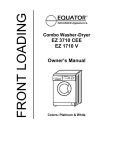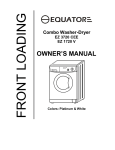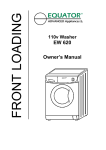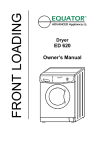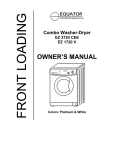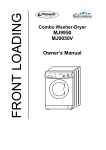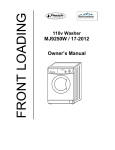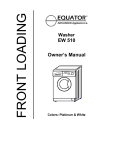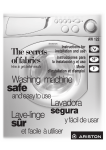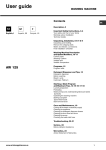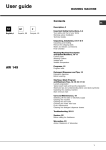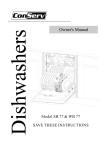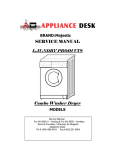Download Consolidated Brands Super Combo Owner`s manual
Transcript
FRONT LOADING SUPER COMBO OWNER’S MANUAL Warranty……………………………………………………………………………...1 …………………………………………………………………........2 Introduction ………………………………………………………………………….3 Important Safety Instructions ………………………………………………………4 Safety ..................................................……………………………………………5 Diagram of the Combo …………………………………………………………......6 Installation Instructions ………………………………………………………….....7 Electrical .....................……………………………………………………………..9 Plumbing .........................………………………………………………………….10 Ventilation Instructions Program Selection Chart ………………………………………………………….15 Operating Instructions ...…………………………………………………………..16 Understanding Fabric Care Labels ……………………………………..............19 Winterizing your Combo ...……………………………………….……………… 19 Maintenance ......………………………………………………….……………… 20 Stain Removal Chart .…………………………………………….……………… 21 Troubleshooting .………………………………………………….……………… 23 new Combo Washer-Dryer WARRANTY INFORMATION Your appliance is protected by this warranty under and limited commercial use (90 days), WARRANTY Consolidated Brands undertakes to the consumer-owner to repair or, at our option, to replace to replace any part of this product which proves to be defective in workmanship or material under normal personal, family or household use, in the USA and Canada, for a period of one year from the date of original purchase. For commercial use, the product is warranted for a period of 90 days. During this period, we will provide all labor and parts necessary to correct such defect, free of charge, if the appliance has been installed and operated in accordance with the written instructions with the appliance. Ready access to the appliance, for service, is is the responsibility of the consumer-owner. EXCLUSIONS In no event shall Consolidated Brands be liable for incidental or consequential damages or for damages resulting from external causes such as abuse, misuse, incorrect voltage or acts of God. This warranty does not cover service calls which do not involve defective costs for a service call which does not involve defective workmanship or materials will be the responsibility of the consumer -owner. Specifically, the following work is not covered under warranty and does not constitute warranty work: Installation – e.g. improper hook-up or leveling or non-removal of shipping rods Maintenance – e.g. cleaning of air and/or water filter Damage – e.g. replacing broken door handle Most work is covered. The defining factor is, has the machine malfunctioned (Consolidated Brands is responsible) or has the customer omitted or done something to cause machine to malfunction (customer is responsible). Some States do not allow the exclusion or limitation of incidental or consequential damages, so the above limitation or exclusion may not apply to you. 1 WARRANTY SERVICE This warranty is given by: Consolidated Brands 10216 Georgibelle Drive, Suite 900D Houston, TX 77043-5249 For Service: Call 1-800-776-3538 Email: [email protected] Web: www.ApplianceDesk.com Business hours (9:00 a.m. to 5:00 p.m. weekdays). GENERAL Since it is responsibility of the consumer-owner to establish the warranty period by verifying the original purchase date, the Equator Advanced Appliances recommends that a receipt, delivery slip or some other appropriate payment record be kept for that purpose. Remember ts with the Consolidated Brands. You can also register online by typing the following link www.ApplianceDesk.com. This warranty gives you specific legal rights, and you may also have other rights which vary from State to State. All rights reserved. Manual subject to change without notice. 4007606 Electrical Testing Laboratories US N° 4007606 Model Rated Voltage CANADA 4000 110-120V /60Hz 13A 240 W 450 W 13 lbs. 1000 rpm 14 0.05-1(Mpa) 33.5 x 23.6 x 22 (inches) 161 lbs. Spin input power Capacity Spin Speed Programs Dimensions (HxWxD) Net Weight 2 INTRODUCTION Congratulations on your new Super Combo. In addition to its contemporary design, this is a highly sophisticated engineered product that will give you many years of satisfaction. Here are some of the best reasons for buying your Combo 1. Improved Operation With a high spin speed, more water is extracted, allowing improved dry times. 2. Easy Operation This appliance is simple to use as a washer or as a dryer – or it can go seamlessly from wash to the dry functions. 3. Convenience This appliance can be permanently installed and be made portable with the installation of the portability kit (sold separately) where needed. 4. Placement Options - es it a perfect appliance for any Kitchen or -Dryer perfect for placement on each floor of your home. 5. Better Clothing Appearance -Dryer has no agitator to damage your clothes so they look better and last longer. 6. This appliance uses very little water for washing and drying and far less than a standard full-size top-loading washer. 7. Energy Savings This appliance is engineered to provide valuable energy savings when compared to other washer-dryers. 8. Maintenance Since the machine has a self-cleaning pump, this appliance needs no cleaning of lint after drying. Instead, there is a convenient coin trap. 9. Space Savings By combining the two functions of washer and dryer in one unit, the space taken for the second unit, i.e. separate dryer, is saved. 10. Flexible venting option on the ideal dry system depending on availability of a venting outlet. 3 IMPORTANT SAFETY INSTRUCTIONS Your safety and that of your children Your Combo Washer-Dryer has been built in compliance with safety regulations, WARNING – To reduce the risk of fire, electric shock, or injury to persons when using your appliance, follow basic precautions, including the following: 1. Read all instructions before using the appliance. 2. Do not wash or dry articles that have been previously cleaned in, washed in, or spotted with gasoline, dry-cleaning solvents, other flammable or explosive substances, as they emit vapors that could ignite or explode. 3. Do not allow children to play on or in the appliance. Close supervision of children is necessary when the appliance is used near children. 4. Before the appliance is removed from service or discarded, remove the door. 5. Do not reach into the appliance if the tub or drum is moving. 6. Do not install or store this appliance where it will be exposed to the weather. 7. Do not tamper with controls. 8. Do not repair or replace any part of the appliance or attempt any servicing unless specifically recommended in the user-maintenance instructions or in published user-repair instructions that you understand and have skills to carry out. 9. Do not add gasoline, dry-cleaning solvents, or other flammable or explosive substances to the wash water. These substances give off vapors that could ignite or explode. 10. Under certain conditions, hydrogen gas may be produced in a hot water system that has not been used for 2 weeks or more. HYDROGEN GAS IS EXPLOSIVE. If the hot water system has not been used for such a period, before using a washing machine or combination washer-dryer, turn on all hot water faucets and let the water flow from each for several minutes. This will release any accumulated Hydrogen. Do not use fabric softeners or products to reduce static unless recommended by the manufacturers of the fabric softener product. 12. Do not use heat to dry articles containing foam rubber or similarly textured rubber-like materials. 13. Check the Coin Trap every few months to remove any coins, buttons or similar size objects. 14. For vented washer-dryers keep the exhaust opening and surrounding areas free from accumulation of lint, dust, and dirt. 15. Do not place items exposed to cooking oils in your dryer. Item contaminated with cooking oils may contribute to a chemical reaction that could cause a load to catch fire. SAVE THESE INSTRUCTIONS 4 SAFETY CAUTION RISK OF ELECTRIC SHOCK DO NOT OPEN ELECTRIC SHOCK, DO NOT REMOVE COVER (OR BACK). NO USER PROFESSIONALS. The model number of this product may be found on the back of the unit; the serial number of the label affixed to the back of the unit. You should note the model and serial numbers of this unit in the space provided. Retain this booklet as a permanent record of your purchase to aid in identification in the event of theft. MODEL# SERIAL# HELPFUL HINTS FOR DRYER EFFICIENCY 1. Your Washer-Dryer spins at a high 1000 rpm spin speed, which will extract more water especially from absorbent fabrics and reduce the degree of dampness as the machine goes into the drying mode. This will cut down on your drying time. 2. FABRIC SOFTENER: After the wash cycle, the clothes can get stuck to the sides of the drum. USING LIQUID FABRIC AND TUMBLE IN THE DRY CYCLE. THIS HELPS DRY CLOTHES FASTER AND CAUSES LESS WRINKLES. 3. OVERLOADING: The drum has a capacity of 13 lbs (1.72 cu. ft.) While this unit has one of the largest drum available on any combination washer-dryer, it is smaller than a standard U.S. washer. drum should not be overloaded. With too many clothes, airflow is reduced, increasing drying time. The drum should be filled to a maximum 2/3 rd full. 4. OVER DRYING: The condensing dryer uses cold water is used to condense the moisture from the hot air. Since there is no external exhaust system, the moisture remains in the machine. Frequently, when it seems the clothes are damp, it is actually the remaining moisture (like dew). Take clothes out and within a few minutes they will be dry. Do not over dry the clothes. The exhaust system uses air-dry. 5. USE HIGH EFFICIENCY (HE) DETERGENT: By using High Efficiency (HE) detergent, you are preventing suds from entering the condensing chamber. When suds enter the condensing chamber, tlhe particles can clog up the chamber and the fan blower. Over time, this reduces drying efficiency and may require the fan blower (impeller) to be cleaned. For this and all other front -loading/horizontal-axis units, High Efficiency (HE) detergents go a long way to improve the efficiency of the units. 6. SORTING: When sorting laundry always take into consideration the quantity and type of fabric contained in the load. Highly absorbent fabrics such as those used in towels or jeans will absorb more water and become very heavy when saturated. If you notice that your clothes are taking longer than usual to dry you may be overloading the machine, or washing too many highly absorbent articles for a single load. PRE-INSTALLATION 1. The unit must be installed on a strong level floor, and in protected, dry, and well-ventilated area close to a power and water supply of sufficient capacity, and a sufficient outlet. 2. • Carpets – place on light carpet only. – brace floor with screws and place additional sheets of plywood before installation. 3. This unit’s installation and grounding should be done in accordance with local codes by a qualified installer. “Installation Instructions” are included in this manual for the Installer’s reference. 4. with minimum 15 Amps, It should not be controlled by a wall switch or pull cord which might be turned off accidentally. 5 DIAGRAM OF THE COMBO WASHER-DRYER Drain Hose Power Cord Control Panel Drum Detergent Dispenser Door Shipping Rod Adjustable Feet Factory-supplied Parts Inlet hose (2) U-Connector for Drain hose 6 Cap for shipping rod hole (2) ! DANGER Factory-supplied equipment ! Inside the drum there is a packet of accessory parts supplied with your washer. Check that all the accessory parts supplied for your model are there. If any parts are missing contact your dealer. Frozen hoses can tear/burst. Do not install the washing machine outdoors or in an area exposed to freezing condition. Any residual moisture inside the drum is due to the final testing which every washing machine undergoes before leaving the factory. If the washing machine is located in a room which will be exposed to temperatures below freezing point, or if it is located in a cabin that is being shut down for the winter, any residual water in the pump or water inlet hoses must be drained. Installation area Do not hold on to protruding parts (e.g. loading door) when lifting. ! The shipping package has protected your new washing machine on its way to your home. All packaging materials are non-polluting and recyclable. Please contribute to a better environment by disposing of packaging materials in an environmentally conscious manner. DANGER ! Appliance stability is very important otherwise the washing machine could “wander” during the spin cycles. Disposing of the packaging ! DANGER The installation area must be solid and even. Soft floor surfaces, such as carpets or surfaces with foam backing, are not suitable. Removing the shipping rods ! ! Keep children away from shipping carton and packaging components. Danger of suffocation from plastic foil and folding cartons. CAUTION ! The shipping rods must be removed before using the appliance for the first time and must be retained for any future transport(e.g. when moving). Disposing of your old appliance Old appliances are not worthless trash! Valuable raw materials can be recycled from old appliances. To prevent children from locking themselves in the appliance, disable the door lock or remove the door. 7 UNPACKING, LEVELING & POSITIONING -Dryer is undamaged. If you have any doubt, -Dryer and call Customer Service. Keep all packing parts (plastic bag, foam rubber, screws, etc.) out of the reach of children since they could be dangerous. Important -Dryer consists of a free floating drum that is affixed with shipping rods at the back of the cabinet (Fig.1) during transport. Before starting the machine, remember to remove the shipping rods (Fig.2) . Close the holes left open by the rods with the plastic caps provided (Fig. 3). It is important for the machine to be perfectly level. For this reason, the machine is fitted with adjustable feet used for leveling the machine before use (Fig.4). Fig.2 Fig.1 1 2 Fig.3 Fig.4 8 ELECTRICAL CONNECTION Connect the plug to a power outlet – 110V/60Hz with minimum 15 Amps. Make sure that the voltage and frequency available correspond with those stated on the serial number plate located on the machine. Do not use adaptors or extension cords since they could result in overheating and burn out. POWER SUPPLY CAUTION: NEVER USE AN EXTENSION CORD WITH THIS APPLIANCE. This dryer must be connected to n individual circuit identical to the one specified on the rating plate of the loading port protected by fuses or circuit breaker conforming to local codes. GROUNDING INSTRUCTIONS This appliance must be grounded. In the event of malfunction or breakdown grounding will reduce the risk of electric shock by providing a path of least resistance for electric current. The plug must be plugged into an appropriate outlet that is properly installed and grounded in accordance with all local codes and ordinances. WARNING : Improper connection of the equipment grounding conductor can result in a risk of electric shock. Check with a qualified electrician or serviceman if you are in doubt as to whether the appliance is properly grounded. Do not modify the plug provided with the appliance-if it will not fit theoutlet; have a proper outlet installed by a qualified electrician. Note: if the electrical power supply does not meet the specifications listed below, call a licensed electrician. GROUNDING This appliance must be grounded. In the event of malfunction or breakdown, grounding will reduce the risk of electric shock by providing a path of least resistance for electric current. This appliance is equipped with a power cord having an equipment-grounding conductor and a grounding plug. The plug must be plugged into an appropriate outlet that is properly installed and grounded in accordance with all local codes and ordinances. WARNINGS - - Improper connection of the equipment-grounding conductor can result in a risk of electric shock. Check with a qualified or service representative or personnel if you are in doubt as to whether the appliance is properly grounded. Do not modify the plug provided with the appliance: if it will not fit the outlet, have a proper outlet installed by a qualified electrician. 9 PLUMBING CONNECTING TO THE WATER FAUCET Please read the following steps carefully 1. Connect the straight end of the hot-water hose to the hot-water faucet (Fig.5) 2. Connect the straight end of the cold-water hose to the cold-water faucet (Fig.5) 3. Connect the L-shaped end of the hot-water hose to the inlet valve marked “H” (Fig.6) 4. Connect the L-shaped end of cold-water hose to the inlet valve marked “C” (Fig.6). CONNECTING THE DRAIN HOSE Connect the drain hose to a drain duct (with internal diameter of at least 1.6 inches) or place it for drainage in to a sink or a tub, ensuring that there are no kinks or bends. The free end must be at a height of 24”-40” from the floor. The hose can be held in place using the black plastic clamp on the upper part of the back panel (Fig.6) Cold water faucet Hot water faucet C H (Fig.5) (Fig.6) Height difference between the installation location of the washing machine and the drainage point: Minimum 24”, and Maximum 40”. - Attach water drain hose to U-Connector. - Hook the U-Connector over the side or stand pipe (Fig 7.) - When the water is being drained, check that the water flow out of the hose is adequate. (Fig.7) 10 Connecting the dryer vent duct For venting function, the machine vents the moist hot air out of the unit and requires a vent duct to be installed. 1 connector 1(Fig.8). 2 INSTALLATION INSTRUCTIONS FOR EXHAUST Fig.8 IMPORTANT: Installation and service must be performed by a qualified installer. Please have a qualified service agent install your dryer. NOTE: The WARNING and IMPORTANT instructions appearing in his manual are not meant to cover all possible conditions and situations that may occur. It must be understood that common sense and being careful are factors that CANNOT be built into the dryer. These factors MUST BE supplied by the persons installing, maintaining, or operating the dryer. This dryer comes ready for top exhausting. WARNINGS DUE TO RISK OF FIRE USE ONLY METALLIC DUCT (RIGID OR FLEXIBLE). Never use flexible duct inside the dryer. Do not terminate exhaust in a chimney, range hood, gas vent, floor or attic. The combination of lint and grease could create a fire hazard or damages. Provide an access for inspection and cleaning the exhaust system at least once a year. EXHAUST LENGTH The MAXI OWABLE length of the exhaust system depends on the type of exhaust hood (wall cap), and all conditions noted below. The maximum allowable length for both rigid and flexible metal duct is shown in the table 1 (next page). More than four 90° turns is not recommended. EXHAUST SYSTEM CHECK LIST HOOD OR WALL CAP Terminate in a manner to prevent back drain or entry of birds or other wildlife. Termination should present minimal resistance to the exhaust air flow and should require little or no maintenance to prevent clogging. s must be installed at least 12” (30 cm) above ground level or any other obstruction with the opening pointed down. If roof vents or louvered plenums are used, they must be equivalent to a 4” (10 cm) dampened wall cap in regard to resistance to air flow. Prevention of back drafts and regular maintenance are required to prevent clogging. 11 SEPARATION OF TURNS Separate all turns by at least 3ft. (1m) of straight duct, including distance between last turn and dampened wall cap. If two turns must be closer than 3ft. (1m) deduct 10ft. (3m) from the maximum lengths shown in the table for each occurrence. TURNS OTHER THAN 90° One turn of 45°or less may be ignored. Two 45°turns should be treated as one 90° Each turn over 45°should be treated as one 90°. SEALING OF JOINTS All joints should be tight to avoid leaks. The male end of each section of duct must point away from the dryer. Do not assemble the duct work with fasteners that extend into the duct. They will serve as a collection point for lint. Duct joints can be made air and moisture-tight by wrapping the overlapped joints with duct tape. INSULATION Duct work which runs through an unheated area or is near an air conditioning duct, should be insulated to reduce condensation and lint build up and be sloped down toward outdoors. NOTE: Never install screen inside exhaust duct. WARNING: THIS MACHINES MUST BE EXHAUSTED OUTDOORS WHEN OPERATED IN THE 12 RECESSED, CLOSET AND ALCOVE INSTALLATION The installation spacing is in inches and is the minimum acceptable. Other installations must use the minimum dimension indicated. Minimum clearances between dryer cabinet and adjacent walls are: 2″ either side and 3″ front and rear. Minimum vertical space from floor to overhead cabinets, etc. is 52″ (132cm). Closet door must be louvered or otherwise ventilated and must contain a minimum of 60 sq. in. of open area equally distributed. If this closet contains both a washer and a dryer, doors must contain a minimum of 120 sq. in. of open area equally distributed. No other fuel-burning appliance shall be installed in the same with closet with dryer. ★ Additional clearances for wall, door and floor molding may be required. ★★ Additional space is needed when an external exhaust elbow is used. NOTE: If a door is installed that potentially encloses the unit while running, the door must allow for a minimum of 20 square inches of free air movement. There must also be a 1” Additional spacing should be considered for easy installation, servicing and compliance with space in front of the unit to the closed door and 1” from the back of the unit to the wall. applicable local, state, and federal codes. For Venting Use , see Fig 9, For Condensing Use, see Fig 10. (Fig.9) 2" 2" 3" 3" (Fig.10) 2" 2" 3" 3" 13 SPECIAL INSTALLATION REQUIREMENTS M Minimum clearances to combustible surfaces: 2’’ clearance both sides and 3’’ rear. M The dryer must be exhausted to the outdoors with the termination securely fastened to the mobile home structure. (See EXHAUST INFORMATION section.) The exhaust MUST NOT be terminated beneath the mobile home. Provisions must be made for the introduction of outside air into the dryer. The free air opening shall not be less than 12 sq. inches. . The exhaust duct material The dryer must be attached to the floor following instructions available from the dealer. Installation must comply with the current CAN / CSA Z240MH series Mobile Home Installation Codes. NOTE 14 PROGRAM SELECTION CHART Program 1 – Heavy 2 – Towels Description of Features load Suggested Drying heat and times Thick cottons (towels, jeans) Mixed cottons (t-shirts, jeans) Hot water wash 1000 rpm spin Hot water wash 1000 rpm spin Full heat 60 minutes Full heat 60 minutes Full heat 60 minutes Full heat 60 minutes 3 – NORMAL Mixed cottons 4– Cotton blends, light fabrics Warm water wash 1000 rpm spin Cold water wash 1000 rpm spin 5 – Kids Cotton blends, light fabrics Warm water wash 500 rpm spin Half heat 60 minutes 6 – Delicate Silks Cold water wash 500 rpm spin Half heat 60 minutes Cold water wash 500 rpm spin No heat Tumble dry only 7 – Wool DRYER HEAT There is no heat in the wool cycle. 15 1. Make sure the Combo Washer-Dryer is turned off. (Power Indicator light should be off). 2. Separate clothes by type, color and degree of soiling. 3. Load clothes of the selected type loosely into the drum. If you are only washing clothes, you can fill the drum. However, if you are washing and then drying, please don’t load clothes more than 2/3 full. 4. Close the Washer-Dryer door. You will hear a click when it is correctly closed. 5. Add detergent to Dispenser A. Use High Efficiency (HE) detergent about 1 table spoon. If desired, you can add about 1 tablespoon. If desired, you can add pre - wash detergent and fabric softener as shown in the diagram to Dispenser B and C. Detergent Dispenser C B Dispenser A Detergent for main wash Dispenser B Fabric softener Dispenser C Detergent for pre-wash. Note: concentrated fabric softener must be diluted with a little water before being poured into the dispenser (prevents the overflow from becoming blocked). A Please don’t add detergent in Dispenser C, if the wash program without Prewash cycle Control Panel 1 2 3 4 5 16 6 7 8 9 WASH FUNCTIONS 1 Prewash button Press this button to add pre wash cycle to the wash program, if the laundry to be washed is heavy or dirty. Water Level 2 button Press this button to change the initial water level of the selected program. Delay Start 3 button Press this button to select the delay time options from 1 to 24 hours in one hour increments. If a change is to be made after the start time is set, turn the dial to “OFF” position, select the desired program again, and then press this button. Press this button Graphic 4 Display Display the selected program and its condition, such as the temperature, spin speed, remaining time, rinse times, water level, and error messages. DRY FUNCTIONS Venting or Condensing 5 selection button 6 7 8 Press this selection button for 5 seconds to select either the venting dry cycle, or the condensing dry cycle. The default condition is the condensing cycle, and if you select the venting cycle, the symbol will be displayed. Time - button Press this button to decrease the dry time from the default start time of 60 minutes in 5 minutes increments. Time + button Press this button to increase the dry time from the initial condition of 60 minutes to 120 minutes in 5 minutes increments. The maximum time is 120 minutes. Program Dial Turn this dial to power on/off, and select one of the 14 available programs depending on the laundry Start/Pause 9 button Press this button to start or interrupt the selected washing program. The indicator light and the display will show the selected program. Pressing the start button will lock the door and the wash cycle will start, until the whole program is completed. In drying cycles, the door can be opened when the symbol displays on the screen. Please do not try to force the door open. Breaking the door handle is not covered by warranty. In the drying cycles, the door can be opened after spinning, the symbol will be displayed on the screen. 17 Selecting the correct drying time, Use the following table as a guide: Fabric Cottons Cottons Mixed fabric (cotton+ polyster) Acrylics Nylon Max load (lbs) Drying Knob Sector (minutes) 8 Full Heat 120 Only terry towels 7 Full Heat 120 Sheets or shirts 5.5 Half Heat 80-90 4 Half Heat 60-70 4 Half Heat 40-50 Load Laundry of Pajamas. Socks etc Petticoats. Stockings etc Denim Alert: Some overalls have straps with hooks that can damage the drum of your washing machine or other garments during the wash. To minimize the risk, place hooks in the pocket and fasten with safety pins. Vacations: unplug the appliance: It is recommended that you should unplug the machine from the socket and turn off the water supply. Leave the door ajar to allow air circulation to the draw and the door gasket area. This will prevent unpleasant odors. 18 The symbols on labels of your garments will help you in choosing the suitable wash program, the right temperature, wash cycles, and ironing methods. Don’t forget to give a glance to these useful indications! Machine Wash Cycle Normal/ Cotton Heavy Duty Water Temp. Permanent Press/ wrinkle resistant Hot (50°C/120°F) Warm (40°C/105°F) Hand wash Delicate/ Gentle Do not wash Do not wring Cold/Cool (30°C/85°F) Tumble Dry Dry Normal/ Permt Press/ Cotton Heavy Duty wrinkle resistant Delicate/ Gentle Do not tumble dry Do not dry Special Instructions Line dry/ Hang to dry Drip dry Dry flat In the shade Bleach Symbols Bleach No-chlorine bleach Do not bleach To winterize your Washer -Dryer please, follow the instructions below to avoid damage to your unit due to freezing: 1. With the unit off, remove coin trap. This will allow the water remaining in the pump and drain hose to be evacuated. Replace coin trap. 2. Close the water faucets and disconnect the inlet hoses. There should be no water in the hoses where they attach at the back of the machine. IF ANTIFREEZE IS BEING USED IN THE SYSTEM FOLLOW THESE INSTRUCTIONS: (not necessary if the above drain procedure is followed) 1. When putting antifreeze into the water system of your coach, set the washer to th wash setting and allow water to flow into unit until antifreeze is detected. Set the washer knob to the “ Rinse” position and allow water to flow for 10 seconds. ve the majority of the water from the unit. With the unit off, remove coin trap from the unit. This will allow the water remaining in the pump and drain hose to be evacuated. Replace coin trap. 5. If you elect you may close the inlet shut-off valves (provided by installer) and disconnect the inlet hoses. 6. Any water remaining in the unit should contain antifreeze and be protected from freezing. Note: When placing unit into service allow unit to operate for one complete cycle before doing laundry to ensure all antifreeze has been purged from the unit. If you have any further questions pertaining to this matter please contact 19 MAINTENANCE Your -Dryer has been designed to operate with easy maintenance. Follow these simple maintenance procedures to obtain optimum performance: 1. Ensure that your machine was installed according to the correct installation procedures detailed in this Manual. 2. Do not use solvents either to clean the machine or to wash clothes. 3. Keep the inside of the detergent dispenser clean; 4. -Dryer is a self-cleaning pump. It is therefore not necessary to carry out cleaning and maintenance operations. However, objects (such as buttons, coins, etc) may sometimes accidentally drop into the pump. Since these can’t be expelled through the drain hose, please remove the cover panel at the bottom of the unit by holding down on the small tab and pulling the cover down (Fig. 11), remove the pump cover, and carefully inspect the inside. (Fig.12). Be sure to close the cover after cleaning. The tab should be gently pulled up until you hear a click. Cleaning the coin trap - Switch off the washing machine. Open the service flap. (bottom right corner)(Fig. 11) Carefully unscrew the coin-trap cover. A little residual water will flow out.(Fig. 12) Remove foreign objects/fluff from inside and clean the interior.(Fig. 13) The pump impeller wheel must be able to rotate. Remove detergent residue and fluff from the pump cover thread and pump housing. - Insert the coin-trap cover and screw tight. (Fig.11) (Fig.12) (Fig.13) Cleaning the Detergent drawer and Recess - Press the release lever on the inside of the drawer and pull it out.(Fig. 14) Remove the cap from the compartment of softer. Wash all of the parts under running water. Clean the drawer recess with an old toothbrush.(Fig.15, Fig. 16) Reinsert the cap (Pushing it firmly into place). Push the drawer back into place. Run a rinsing program without any laundry in the drum. (Fig.14) (Fig.15) 20 (Fig.16) Blood Cosmetics: eye shadow, lipstick, liquid make-up, mascara, powder, pancake make-up or rouge Rin detergent into any remaining stain. Rinse. If stain persists, put a few drops of ammonia on stain and repeat detergent treatment. Rinse. If necessary bleach. Apply undiluted liquid detergent to stain, or dampen stain and rub in soap or detergent stain is gone, rinse well. Repeat if necessary. If color remains, bleach if safe for fabrics. Burn Marks into stain. Rinse. Bleach, if necessary. Stain may be impossible to re move Cream, Ice Cream or Milk Sponge stain with cool water or soak stain in cool water for 30 minutes or longer. If stain remains, work a detergent in- to spot then rinse. Bleach if necessary. Candle Wax Scrape off excess. Place stain between clean white blotters or several layers of facial tissues. Press with warm iron. Sponge with cleaning fluid. If dye spot remains, bleach. Deodorants and Antiperspirants Rub with ice to harden. Scrape off excess with dull blade. Sponge with cleaning fluid. Wash or sponge stain thoroughly with warm water and detergent; rinse. If stain remains, bleach with hot sudsy water. Launder. You may be able to restore fabric color by sponging with ammonia. Rinse thoroughly. Chocolate or Cocoa Dye Soak 15 minutes in cold water. Rub detergent paste into stain, then rinse thoroughly. Launder in hottest water safe for fabric. If colored stain remains, sponge with hydrogen peroxide, rinse and launder. Rinse or soak in col into stain. Rinse. If necessary, bleach. Stain is not always possible to remove. A commercial color remover may also be used. Chewing Gum Egg or Meat Juice Cod liver Oil Rinse in cold water. If stain remains, sprinkle with meat tenderizer, let stand 15-20 minutes. If stain still remains, sponge with cleaning fluid or diluted bleach. Launder in hot water. The use of hot water first may set stain. Sponge article with cleaning fluid. Soak in warm suds. If stain persists, wash with bleach safe for fabric. To remove yellow stain, sponge with hydrogen peroxide. Rinse and launder. Old stains may be nearly impossible to remove. Fabric Softener Stain Rub with bar soap until stain has lightened. Rinse thoroughly. Launder. Rubbing alcohol is sometimes effective in the color of the garment can take it. Launder. If desired, dry cleaning can be used. Coffee or Tea (Black) Soak fresh stains immediately in cold water. Then use bleach treatment with hottest water safe for fabric. Or if safe for the fabric pour boiling water through spot from a height of 1 to 3 feet. Launder. Felt tip pen Spray spot with cleaners suitable to this purpose. Sponge stain thoroughly. Rinse with cold water. Reapply cleaner if necessary . into stain. Rinse. Dry. If grease stain remains, sponge with cleaning fluid. Repeat, if necessary. If stain remains, bleach. Soak fresh stains immediately with cool water. Then use bleach treatment with hottest water 21 safe for fabrics, pour boiling water through spot from a height of 1 to 3 feet. Launder. frequently. Launder with water at temperature suitable for fabric. Do not use acetone on acetate, arnel, dynel or rayon. Grass Paint denatured alcohol. Bleach, if necessary. Sponge or soak in turpentine or solvent recommended as a thinner on label. Launder. Grease or Oil Scrape away excess. Rub detergent paste or a general purpose liquid household cleaner into stain, rinse with hot water. If stain remains, sponge thoroughly with a grease solvent. Dry. Repeat if necessary. To rem ove yellow stain, use a chlorine or oxygen bleach. Perfume Ink. Ball-point Wash or sponge stain thoroughly with warm water and detergent paste. If perspiration has changed the color of the fabric, restore it by treating with ammonia or vinegar. Apply ammonia to fresh stains; rinse with water. Apply vinegar to old stains; rinse with water. Rinse in cold water. Rub undiluted liquid detergent or a detergent paste into stain. Rinse. If stain remains, bleach. Perspiration Same ball-point inks are set by water. First test a scrap of cloth. Sponge stain repeatedly with acetone, amyl acetate or rubbing alcohol. Hair spray is effective. Launder. Bleach if necessary. Use amyl acetate on triacetate, arnel, dynel and verel. Use acetone on other fabrics. NOTE: Some inks cannot be removed. Rust and Iron Apply commercial rust remover, according to Equator Advanced Appliances’s directions. Rinse. Or, if safe for fabric, boil stained article in solution of 4 teaspoons of cream of tartar to 1 pint water. Ketchup Scrape of excess. Soak in cold water 30 minutes. Pre-treat with a detergent paste. Launder. Shoe Polish Mildew Brush off surface growth to keep mold spores from spreading. Dip article into solution of ½ cup bleach per 1 gallon of cool sudsy water for 5 to 10 minutes. Rinse well. Launder. Scrape off as much as possible. Pre-treat with a detergent paste; rinse. If stain persists, sponge with rubbing alcohol (1 part to 2 parts water) or turpentine. Remove turpentine by sponging again with warm detergent solution or with alcohol. Bleach if necessary. Mud Let stain dry; then brush well. Rinse repeatedly in cool water until mud comes out. Launder. (Hot soaps suds set a red or yellow clay stain). Soft Drinks Sponge with cold water, some stains are invisible when they have dried, but turn brown when heated and may be impossible to remove. Mustard Soak in hot detergent water for several hours. If stain remains, bleach. Tar and Asphalt Act quickly before stain is dry. Sponge with grease solvent or turpentine. Launder. Nail Polish Treat while fresh, scraping or wiping off as much as possible, before it dries. Place stain face down on white paper towels. Sponge back of stain acetone (nail polish remover) or sponge with denatured alcohol and a few drops of household ammonia. Sponge stain Urine Soak in cool water. If stain is dry, work a detergent paste into the spot then rinse. If necessary, bleach. 22 TROUBLESHOOTING In most cases, when your washer-dryer fails to work, the problems arising can be easily solved without having to call for a technician. Before calling for assistance, always check these points. The washer-dryer fails to start Is the plug correctly inserted into the socket? Is there electricity in the house? Is the door closed properly? Is the start button pressed? Is the Washer knob in the correct position for the cycle to start? Is the water supply turned on? The washer-dryer fails to fill with water Is the hose correctly connected to the faucet? Is there water supply? Is there sufficient water pressure? Is the faucet filter clean? Is the inlet hose kinked? The washer-dryer continuously fills and drains water Is the drain hose positioned too low? Check that the inlet hose is not connected at a height more than 40 inches above the floor. Is the end of the outlet hose immersed in water? The washer-dryer does not drain or spin Does the selected program incorporate water draining? Is the drain pump clogged? Is the drain hose kinked? There are too many suds in the drum Is High Efficiency (HE) detergent being used? It is recommended to use HE detergent. Is the correct amount of detergent being used? The washer-dryer vibrates too much during the spin cycle Have all shipping rods been removed during installation? Has the machine been leveled correctly? Is there space between the machine and adjacent units? Is the machine loaded evenly? Is the machine installed on carpet or on a wooden floor? The washer-dryer leaks Is the metal ring of the inlet hose properly attached? Is the detergent dispenser obstructed? Is the drain hose inserted correctly into the drain? The washer-dryer is not drying Is the plug correctly inserted into the power outlet? Is the door properly closed? Is the dryer knob in the correct position indicating minutes for drying? 23 TROUBLESHOOTING The washer-dryer is not drying efficiently Is the end of the drain hose under water? Is the drain pump obstructed? Is the drum overloaded? Is the cold water faucet open? Is low-sudsing detergent being used? Is fabric softener being used? 24




























